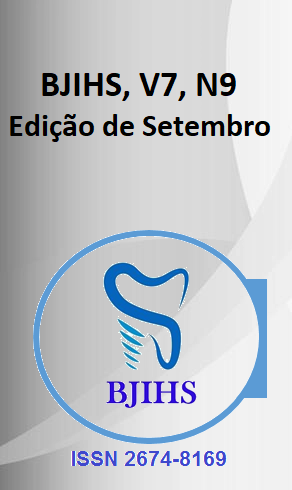Abstract
Visual inspection (clinical examination) is the method of choice in daily clinical practice for detecting carious lesions. However, despite the high specificity (correct identification of healthy sites), visual inspection has achieved not so good values of sensitivity (correct identification of lesions) and reproducibility. As a result, adjunct methods have been proposed to improve the accuracy and reproducibility of lesion detection, and in some cases, to allow for a more objective assessment. The purpose of the present study was to review the literature to point out and compare the methods of detecting caries disease currently available for clinical use, improving the professional's diagnostic capacity.
References
Fejerskov O, Kidd EAM. Dental caries: the disease and its clinical management. Oxford: Blackwell Munksgaard; 2008. 480 p.
Dejean KS, Caldas LD, Gois DN, et al. Lesão de cárie oculta: um estudo de diagnóstico e prevalência. Clin Pesq Odontol UNITAU. 2009;1(1):7-13.
Fejerskov O, Kidd EAM. Cárie dentária: a doença e seu tratamento clínico. São Paulo: Santos; 2005.
Boldieri T. Avaliação do desempenho de métodos baseados em indução de fluorescência na detecção de lesões de cárie residual [tese]. Araraquara: Universidade Estadual Paulista; 2012.
Vieira IS. Etiologia e alternativas de diagnóstico da cárie oculta [dissertação]. Santa Maria: Universidade Federal de Santa Maria; 2006.
Soares GG, Souza PR, Purger FPC, et al. Métodos de detecção de cárie. Rev Bras Odontol. 2012;69(1):84-9.
Mialhe FL, Bosquiroli V, Silva JO. Conhecimento e utilização de métodos de detecção de lesões cariosas por cirurgiões-dentistas. Varia Scientia. 2005;5(10):23-33.
Murdoch-Kinch CA, McLean ME. Minimally invasive dentistry. J Am Dent Assoc. 2003;134(1):87-95.
Marinho VA, Pereira GM. Cárie: diagnóstico e plano de tratamento – revisão de literatura. Rev Univ Alfenas. 1998;4:27-37.
Castro GF, Ribeiro AA, Oliveira CAR. Exame, diagnóstico e planejamento em odontopediatria. In: Maia LC, Primo LG, editores. Odontologia integrada na infância. São Paulo: Grupo Editorial GEN; 2012. p. 87-96.
Amore R, Anido AA, Moraes LC, et al. Comparação entre o diagnóstico clínico e radiográfico da cárie dental. Pós-Grad Rev Fac Odontol São José dos Campos. 2000;3(2):jul-dez.
Hintze H, Wenzel A, Danielsen B, et al. Reliability of visual examination, fibre-optic transillumination, and bitewing radiography, and reproducibility of direct visual examination following tooth separation for the identification of cavitated carious lesions in contacting approximal surfaces. Caries Res. 1998;32(3):204-9.
Kidd EAM, Fejerskov O. What constitutes dental caries? Histopathology of carious enamel and dentin related to the action of cariogenic biofilms. J Dent Res. 2004;83(Spec No C):C35-8.
Sarmento VA, Pretto SM, Costa NP. Entendendo a imagem digitalizada. Rev Odonto Cienc. 1999;14(27):171-8.
Purger FP, Oliveira PRA, Vasconcellos A, et al. Relative importance of radiographs in diagnosing primary molar proximal caries. J Dent Res. 2011;90(Spec Issue):Abstracts.
Wenzel A. Bitewing and digital bitewing radiography for detection of caries lesions. J Dent Res. 2004;83(Spec No C):C72-5.
Freitas L. Radiologia bucal: técnicas e interpretação. 2. ed. São Paulo: Pancast; 2000.
Kalathingal SM, Mol A, Tyndall DA, et al. In vitro assessment of cone beam local computed tomography for proximal caries detection. Oral Surg Oral Med Oral Pathol Oral Radiol Endod. 2007;104(5):699-704.
Ricci HA, Pratavieira S, Junior AB, et al. Ampliando a visão bucal com fluorescência óptica. Rev Assoc Paul Cir Dent. 2013;67(2):129-35.
McComb D, Tam LE. Diagnosis of occlusal caries: part I. Conventional methods. J Can Dent Assoc. 2001;67(8):454-7. PMID: 11583606.
Zanardo A, Rego MA. Diagnóstico de cárie oclusal em dentes permanentes: estudo in vitro. Cienc Odontol Bras. 2003;6(3):50-7.
Haak R, Wicht MJ, Hellmich M, et al. The validity of proximal caries detection using magnifying visual aids. Caries Res. 2002;36(4):249-55.
Kuhnisch J, Dietz W, Stosser L, et al. Effects of dental probing on occlusal surfaces: a scanning electron microscopy evaluation. Caries Res. 2007;41(1):43-8.
Kairalla EC, Lage-Marques JL, Rode SM. Avaliação de métodos de diagnóstico da lesão de cárie. Rev Odontol Univ São Paulo. 1997;11(Supl 1).
Seow WK. Pre-eruptive intracoronal resorption as an entity of occult caries. Pediatr Dent. 2000;22(5):370-6.
Costa AM, Bezerra AC, Fuks AB. Assessment of the accuracy of visual examination, bitewing radiographs and DIAGNOdent on the diagnosis of occlusal caries. Eur Arch Paediatr Dent. 2007;8(2):118-22.
Marcucci G. Fundamentos de odontologia: estomatogia. Rio de Janeiro: Guanabara Koogan; 2005.
George K, Stookey M. The evolution of caries detection [Internet]. [cited 2010 Aug 18]. Available from: http://www.dimensionsofdentalhygiene.com/ddhright.aspx?id=122
Sheehy EC, Brailsford SR, Kidd EA, et al. Comparison between visual examination and a laser fluorescence system for in vivo diagnosis of occlusal caries. Caries Res. 2001;35(6):421-6.
Eggertsson H, Analoui M, van der Veen M, Gonzalez-Cabezas C, Eckert G, Stookey G. Detection of early interproximal caries in vitro using laser fluorescence, dye-enhanced laser fluorescence and direct visual examination. Caries Res. 1999;33(3):227-33.
Ricketts DN, Ekstrand KR, Martignon S, et al. Accuracy and reproducibility of conventional radiographic assessment and subtraction radiography in detecting demineralization in occlusal surfaces. Caries Res. 2007;41(2):121-8.

This work is licensed under a Creative Commons Attribution 4.0 International License.
Copyright (c) 2025 Clarice Moreira Duarte, Emanuelly Dos Santos Bimbato, Letícia Senger De Paula, Rafaelle Da Silva Cardoso, KLISSIA ROMERO FELIZARDO
